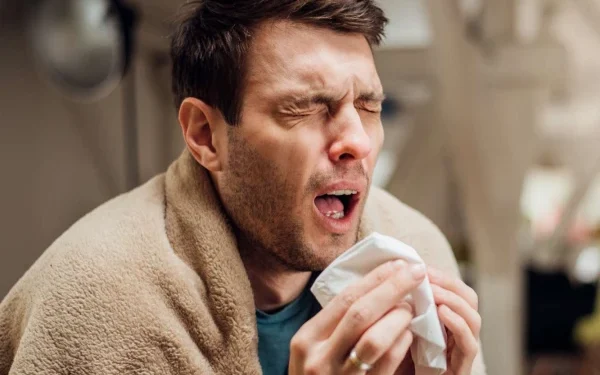Sneezing is a natural reflex of the human body, often dismissed as harmless or simply an inconvenient symptom of a cold, allergy, or viral infection. However, science has repeatedly shown that a single sneeze is far more powerful and potentially dangerous than most people realize. When someone sneezes, it doesn’t just produce sound and inconvenience—it can release hundreds of thousands to millions of viral and bacterial particles into the air, creating a significant public health risk in indoor and crowded spaces.
What Happens During a Sneeze?
A sneeze is the body’s way of expelling irritants from the nasal passages. It typically begins when foreign particles such as dust, pollen, smoke, or pathogens irritate the mucous membranes inside the nose. This irritation sends signals to the brain, prompting a rapid release of air through the mouth and nose.
The Process of Aerosolization
When this burst of air is expelled, it carries with it:
- Droplets: These are relatively large (over 5 microns in diameter) and tend to fall to the ground within a few feet.
- Aerosols: These are much smaller particles (less than 5 microns) and can stay suspended in the air for hours, especially in poorly ventilated areas.
If the individual sneezing is infected with a virus such as the flu, common cold, or COVID-19, these droplets and aerosols can contain thousands to millions of infectious agents, posing a serious risk to people nearby.
How Many Virus Particles Are in a Single Sneeze?
According to research by institutions like the National Institutes of Health (NIH) and Centers for Disease Control and Prevention (CDC), the number of viral or bacterial particles expelled in a single sneeze can range from 100,000 to over 4 million. This figure depends on factors such as:
- The severity of the infection
- The stage of the illness
- The physical characteristics of the sneeze (force, duration, etc.)
- Environmental factors like humidity and air flow
Research Findings
A study published in Nature Medicine found that respiratory droplets can travel up to 27 feet in certain circumstances, especially in enclosed environments. Another study from MIT observed that the droplets emitted during a sneeze are not isolated particles, but part of a mucosal gas cloud that protects and carries them across longer distances than previously assumed.
Why Are Sneezes So Dangerous for Disease Transmission?
Viruses and bacteria rely on transmission from host to host to survive and reproduce. The aerosol and droplet spread during sneezing is one of the most effective means for these pathogens to spread, particularly for respiratory illnesses.
Diseases Commonly Spread by Sneezing:
- Influenza (Flu) – Caused by influenza viruses, often spread through airborne droplets.
- COVID-19 – Caused by the SARS-CoV-2 virus, which is primarily transmitted via respiratory droplets and aerosols.
- Common Cold – Typically caused by rhinoviruses, also spread through sneezing.
- Pertussis (Whooping Cough) – A bacterial infection that spreads through coughing or sneezing.
- Tuberculosis (TB) – A serious bacterial infection that can be airborne.
- Measles – A highly contagious viral disease that can linger in the air for up to two hours after a sneeze.
The small size of aerosolized particles allows them to bypass many of the body’s natural defenses (like nose hairs and mucus), entering deep into the lungs and causing infections. In high-density spaces such as public transport, offices, and classrooms, this mode of transmission becomes especially dangerous.
How Far Can Sneeze Droplets Travel?
One of the most alarming aspects of sneezing is the distance the particles can travel. Studies have shown:
- Larger droplets can travel up to 6 feet before falling to the ground.
- Smaller aerosols can linger and float in the air for hours, traveling across a room or down hallways via air currents.
- Environments with poor ventilation can concentrate viral particles, increasing the likelihood of inhalation by others.
This means that simply being in the same room as an infected person—even if they are across the room—can lead to infection if proper precautions are not taken.
How to Protect Yourself and Others: Essential Precautions
1. Use a Tissue or Elbow When Sneezing
Covering your mouth and nose when sneezing helps trap droplets, preventing them from entering the surrounding air. Using a tissue is ideal because it can be disposed of immediately. If a tissue isn’t available, sneezing into your elbow or upper sleeve is recommended.
2. Wear a Face Mask
Face masks have become an essential part of personal protection during the COVID-19 pandemic. Even after the height of the crisis, wearing a mask in crowded or enclosed spaces helps minimize the spread of respiratory droplets during sneezing or coughing.
3. Wash Hands Regularly
Since droplets can settle on your hands or nearby surfaces, hand hygiene is critical. Washing your hands with soap for at least 20 seconds or using an alcohol-based sanitizer helps prevent hand-to-mouth or hand-to-eye transmission.
4. Avoid Touching Your Face
Sneezing can release particles onto your hands and face. Avoid touching your eyes, nose, or mouth to minimize the chance of transferring viruses from surfaces or your hands into your body.
5. Maintain Social Distancing
Staying at least 6 feet apart from others can reduce the risk of inhaling respiratory droplets. This is especially important in areas where viral infections are spreading rapidly.
6. Improve Ventilation
Ensuring good air circulation in indoor environments—through open windows, air purifiers, or HVAC systems—helps disperse and dilute airborne particles, lowering the risk of airborne disease transmission.
Why These Habits Matter: Preventing the Spread of Deadly Diseases
Small, everyday actions like sneezing into a tissue, wearing a mask, and washing hands may seem minor, but they are critical components of public health defense mechanisms. During flu seasons and viral outbreaks, these measures can:
- Reduce the rate of transmission
- Protect vulnerable populations (elderly, immunocompromised)
- Ease the burden on healthcare systems
- Prevent secondary infections in healthy individuals
In fact, these simple precautions are credited with helping reduce the spread of seasonal influenza during the COVID-19 pandemic, proving their effectiveness beyond a single virus.
Conclusion: A Tiny Action with a Big Impact
While sneezing may seem like a routine bodily function, it is one of the most potent vehicles for viral and bacterial transmission. In a single explosive breath, millions of pathogens can be expelled into the air, creating invisible yet potentially deadly clouds of infection. Understanding the science behind sneezing and taking preventive measures can go a long way in protecting yourself and others from infectious diseases.
By adopting hygienic habits like using tissues, wearing masks, and practicing hand hygiene, we can all play a part in breaking the chain of infection and fostering healthier communities.

























